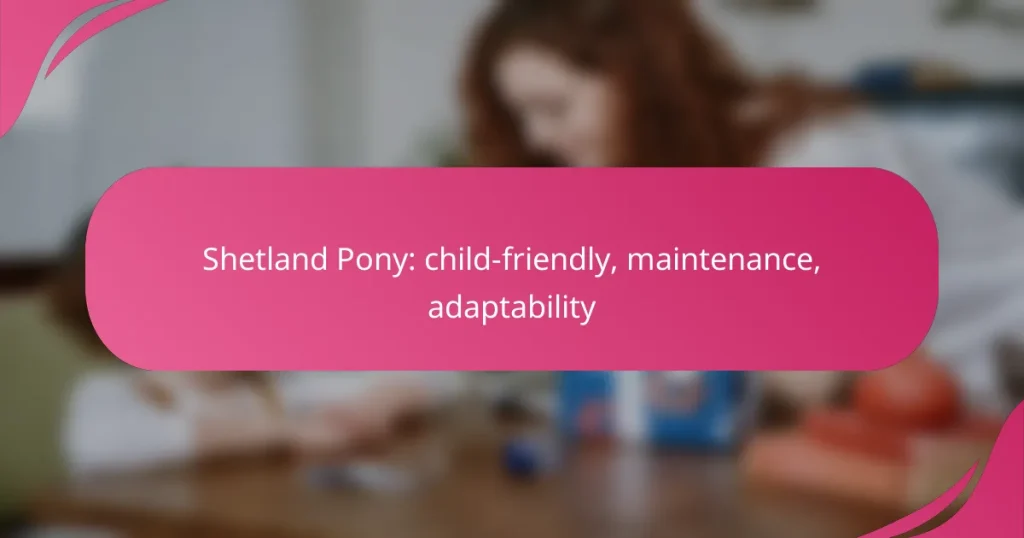Shetland Ponies are renowned for their child-friendly characteristics, including a gentle temperament and manageable size, making them perfect companions for young riders. Their adaptability allows them to thrive in various environments, while proper care in feeding, grooming, and exercise ensures their well-being. These traits make Shetland Ponies an excellent choice for families seeking a safe and enjoyable equestrian experience.

What makes Shetland Ponies child-friendly?
Shetland Ponies are considered child-friendly due to their gentle nature, manageable size, and trainability. These traits make them ideal companions for young riders and families looking for a safe and enjoyable equestrian experience.
Gentle temperament
The gentle temperament of Shetland Ponies is one of their most appealing characteristics. They are known for being calm and patient, which makes them excellent for children who are learning to ride or interact with horses. Their friendly disposition often leads to positive experiences for young riders.
When working with children, it is crucial to ensure that the pony is well-socialized and accustomed to being around kids. This can help prevent any unexpected reactions and promote a safe environment for learning.
Small size
Shetland Ponies are small in stature, typically standing between 28 to 42 inches tall at the withers. This size makes them less intimidating for children compared to larger horse breeds. Their compact build allows kids to handle them more easily and gives parents peace of mind.
When selecting a Shetland Pony for a child, consider the pony’s weight and strength relative to the child’s size. A well-matched pony can enhance the riding experience and ensure safety during interactions.
Trainability
Shetland Ponies are known for their intelligence and willingness to learn, making them highly trainable. They respond well to positive reinforcement techniques, which can be particularly effective when teaching children how to ride and care for them. Simple commands and groundwork can be mastered with consistent practice.
To maximize trainability, start with basic commands and gradually introduce more complex tasks. Patience and consistency are key, as young ponies may require extra time to adapt to new experiences.
Social behavior
Shetland Ponies are inherently social animals and thrive on companionship. They often form strong bonds with humans and other animals, making them great additions to family settings. Their sociable nature encourages children to engage with them, fostering a sense of responsibility and empathy.
When introducing a Shetland Pony to a child, ensure that the pony has opportunities for social interaction, whether with other ponies or through regular handling. This will help develop a trusting relationship and enhance the overall experience for both the child and the pony.

How to care for a Shetland Pony?
Caring for a Shetland Pony involves meeting their specific needs in feeding, grooming, health check-ups, and exercise. These small ponies are known for their friendly nature and adaptability, making them suitable companions for children and families.
Feeding requirements
Shetland Ponies require a balanced diet that primarily consists of high-quality hay and pasture grass. Depending on their age, activity level, and health, they may need additional supplements, such as vitamins and minerals, to ensure proper nutrition.
Typically, an adult Shetland Pony consumes about 1.5% to 2% of its body weight in forage daily. It’s essential to monitor their weight to prevent obesity, as these ponies can easily gain excess weight if overfed.
Grooming needs
Regular grooming is crucial for maintaining a Shetland Pony’s coat and overall health. This includes brushing their coat to remove dirt and loose hair, checking their hooves for stones or debris, and ensuring their mane and tail are free from tangles.
Grooming sessions should occur at least once a week, but more frequent grooming is beneficial, especially during shedding seasons. This practice also helps strengthen the bond between the pony and its owner.
Health check-ups
Routine health check-ups are vital for a Shetland Pony’s well-being. Annual veterinary visits should include vaccinations, dental care, and parasite control. Regular hoof trimming is also necessary to keep their feet healthy.
Owners should be vigilant for signs of illness, such as changes in appetite or behavior. Early detection of health issues can lead to more effective treatment and a better quality of life for the pony.
Exercise routines
Shetland Ponies need regular exercise to stay healthy and happy. Daily turnout in a safe, fenced area allows them to move freely and engage in natural behaviors. They benefit from structured activities like riding or lunging sessions.
Exercise routines should be tailored to the pony’s age and fitness level, with sessions lasting anywhere from 30 minutes to an hour. Consistent activity helps prevent obesity and promotes overall well-being.

What is the adaptability of Shetland Ponies?
Shetland Ponies are highly adaptable animals, capable of thriving in various environments and conditions. Their resilience allows them to adjust to different climates, living situations, and interactions with other animals.
Climate resilience
Shetland Ponies are known for their strong climate resilience, which stems from their origins in the harsh Shetland Islands. They can tolerate cold temperatures and wet conditions, making them suitable for regions with similar climates.
However, they can also adapt to warmer climates, provided they have access to shade and fresh water. Regular grooming helps manage their thick coats, especially in hotter weather.
Living conditions
Shetland Ponies are versatile in their living conditions, thriving in both pasture and stable environments. They require adequate space to roam and graze, ideally with access to grasslands or paddocks.
When kept in stables, ensure proper ventilation and bedding to maintain hygiene. Regular exercise is essential to keep them healthy, so consider daily turnout or riding to meet their activity needs.
Compatibility with other animals
Shetland Ponies generally get along well with other animals, making them suitable for mixed herds. They can coexist peacefully with larger horses, goats, and even some livestock, provided they are introduced gradually.
However, monitor their interactions, as their small size may make them vulnerable to more aggressive animals. It’s crucial to ensure that all animals have enough space and resources to prevent competition and stress.

What are the costs associated with owning a Shetland Pony?
Owning a Shetland Pony involves various costs, including the initial purchase price, ongoing maintenance expenses, and insurance considerations. Understanding these financial commitments is crucial for prospective owners to ensure they can provide proper care.
Initial purchase price
The initial purchase price of a Shetland Pony can vary significantly based on factors such as age, training, and pedigree. Generally, prices can range from a few hundred to several thousand dollars, with well-bred ponies often costing more. It’s essential to budget for this upfront cost as part of your overall investment.
Ongoing maintenance expenses
Ongoing maintenance expenses for a Shetland Pony typically include feed, bedding, hoof care, and veterinary services. Monthly costs can range from $100 to $300, depending on the pony’s needs and local prices. Regular hoof trimming and vaccinations are necessary to keep your pony healthy and may add to your budget.
Additionally, consider costs associated with equipment such as saddles, bridles, and grooming supplies. Investing in quality gear can enhance your pony’s comfort and performance, but it also requires an initial outlay and ongoing maintenance.
Insurance considerations
Insurance for a Shetland Pony is an important aspect of ownership that can protect you from unexpected expenses. Policies may cover veterinary costs, liability, and theft, with premiums typically ranging from $200 to $600 annually. It’s advisable to shop around and compare different insurance providers to find a plan that fits your needs.
When selecting insurance, consider the pony’s value and your level of risk tolerance. Some owners opt for basic coverage, while others may choose comprehensive plans for peace of mind. Always read the policy details to understand what is included and any exclusions that may apply.

What are the common health issues in Shetland Ponies?
Shetland Ponies are prone to several health issues that owners should be aware of. Common problems include laminitis, obesity, and dental issues, which can significantly impact their well-being if not managed properly.
Laminitis
Laminitis is a painful condition affecting the hooves of Shetland Ponies, often triggered by dietary changes or excessive weight. It occurs when the laminae, the tissue connecting the hoof wall to the bone, become inflamed.
To prevent laminitis, maintain a balanced diet low in sugar and starch, and monitor their weight regularly. If you notice signs like lameness or reluctance to move, consult a veterinarian immediately.
Obesity
Obesity is a significant concern for Shetland Ponies due to their small size and tendency to gain weight easily. Overfeeding and lack of exercise can lead to obesity, which increases the risk of other health issues, including laminitis.
To manage weight, provide controlled portions of hay and limit access to rich pastures. Regular exercise is essential; aim for at least 30 minutes of activity daily to keep them healthy.
Dental problems
Dental issues are common in Shetland Ponies, including overgrown teeth and periodontal disease. These problems can lead to difficulty eating and weight loss if not addressed promptly.
Regular dental check-ups, ideally every six to twelve months, can help catch issues early. Look for signs like dropping food or excessive salivation, which may indicate dental discomfort.

